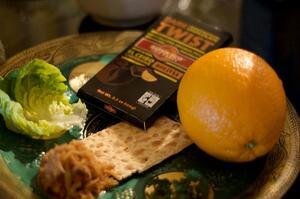A Joyful Struggle
A progressive seder plate with an orange and bar of Fair Trade chocolate.
Courtesy of: awallin on Flickr
I have always struggled at my family’s Passover Seders. My difficulties have not been emotional or spiritual, religious or psychological. My troubles have been purely physical; every year, I wrestle with the giant stack of haggadot next to my plate, which seems intent on toppling over. I spread the books around me, trying to follow my family’s traditional Seder in five or more disparate texts, a linguistic comment here, a poem there.
When I was younger, my pile was not composed just of haggadot. First, Passover-related picture books sat beside me, then “chapter books” about the holiday. There were a few years when I hid novels inside the haggadot, as a means to get through the by-then boring maggid section of the Seder—this was in the gap between when the basic Passover story was thrilling and when I was of an age to read interesting, new interpretations of the narrative. My family has always encouraged my Seder reading. Every year, for as long as I can remember, my parents have bought me a new haggadah, and I’ve borrowed some of theirs to add to my stack as well. (To be fair, I don’t know if they knew about the novel-reading.)
My family runs a fairly traditional Seder. We do a few supplemental readings—the “official” haggadah we use, A Different Night, adds first-person testimonies, poems, and art to the standard text—but the “full” Seder service is read. Consequently, women’s and feminist voices are less prominent. But thanks to my book pile, my Seder experience brims with women’s stories and ideas.
The haggadot I have accumulated and choose to use all have a theme, one which was unintentional; all of them, even those written or edited by men, frequently and prominently cite women’s scholarship and tell their stories. Some of them contain commentary about women’s historical role in the Passover Seder, and some of them contain feminist Torah commentary. Others illuminate the Jewish female immigrant experience, or speak of Second Wave feminism with the vocabulary of liberation.
What I find most meaningful about my pile of books is how indispensable it has become to my experience of Passover. Coupled with the women’s perspectives in our family haggadah, my feminist haggadot are an integral part of the way I reread the narrative of Jewish liberation. The preponderance of woman-centered Passover materials is demonstrative of just how far we’ve come. In my haggadot, I see not just freedom from Egypt, but women’s liberation as well, and I celebrate both, with gratitude and joy.
The Passover narrative is one of both independence and community, liberation and indebtedness. As a Jew, a woman, and a Jewish woman, I am connected to both ancient and recent history, biblical and modern heroines, individual and communal inspiration. In my stack of haggadot, I find it all.
This piece was written as part of JWA’s Rising Voices Fellowship.






